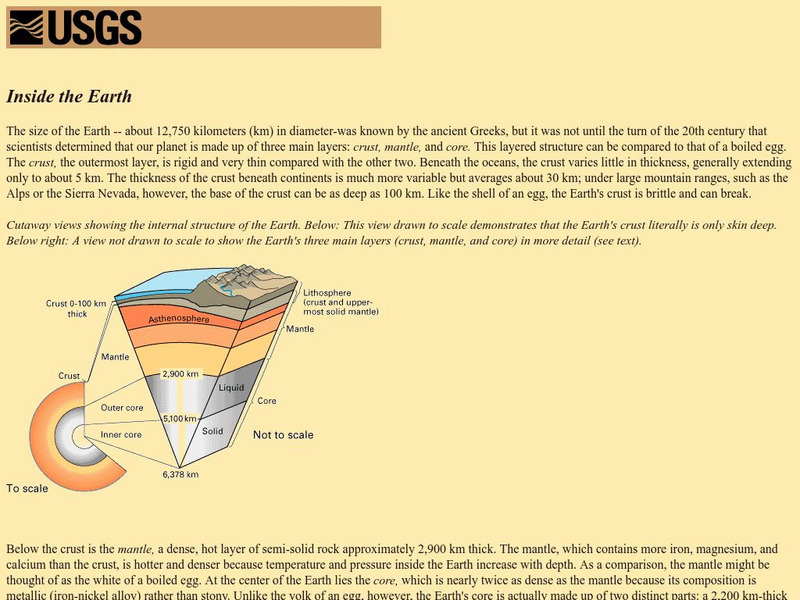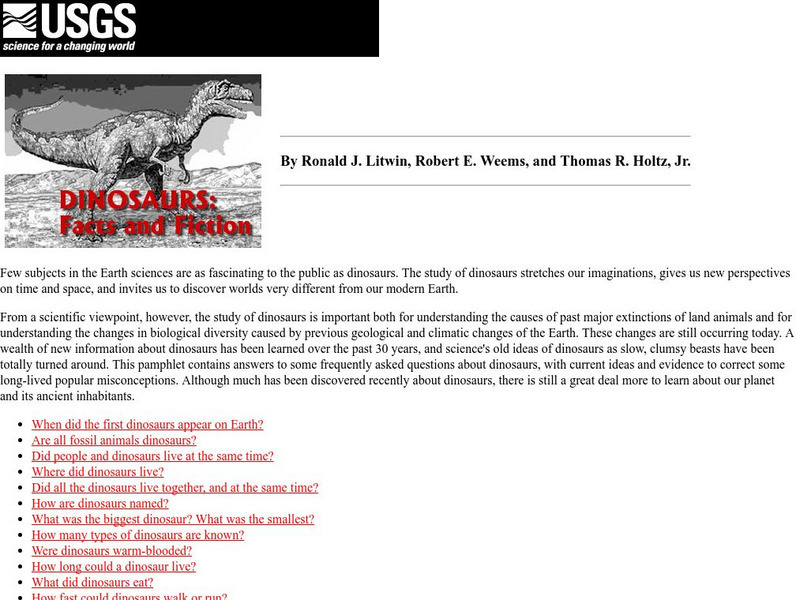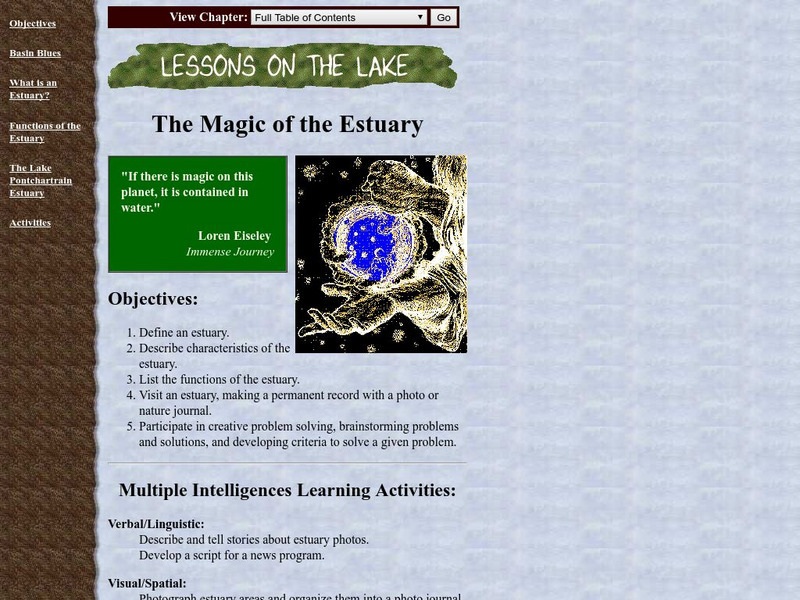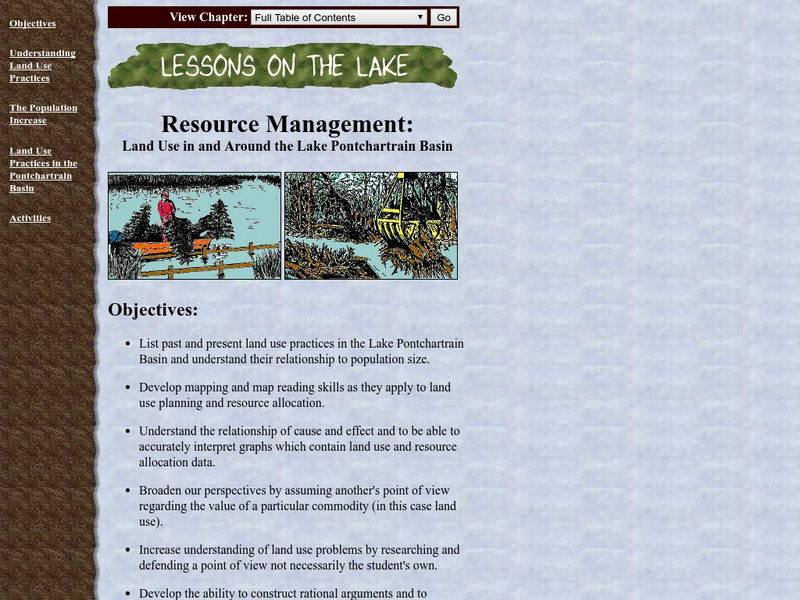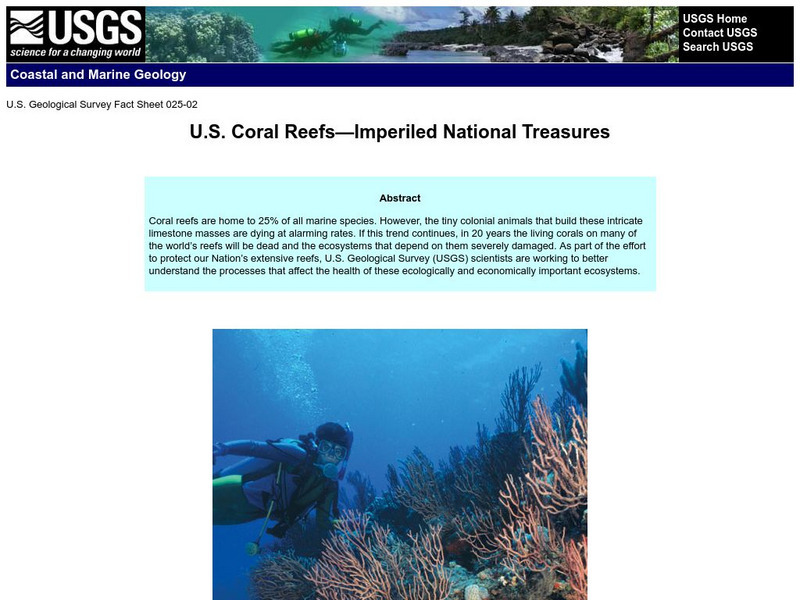US Geological Survey
U.s. Geological Survey: Building Stones of Our Nation's Capital
Pictures and text describe the source and appearance of many of the stones used in the buildings and monuments in Washington, D.C. Included are a geologic time chart and an illustrated map of the geologic and geographic features of the...
US Geological Survey
Usgs: Inside the Earth
This is a website to learn not only about the inner and outer core, but also about the crust and the mantle of the interior of the earth.
US Geological Survey
Mercury in the Geochemical Cycle
Mercury in the geochemical cycle ultimately affects the food chain. Learn about this and its effect on the Everglades.
US Geological Survey
Usgs: Dinosaurs: Fact and Fiction
A comprehensive series of pages that answers a number of commonly asked questions about dinosaurs.
US Geological Survey
U.s. Geological Survey: Gold
Heinrich Schliemann is briefly mentioned as part of a larger discussion about the geology of gold. A brief history of the precious metal refers to the gravesites discovered by Schliemann at the ancient city of Mycenae in Greece.
US Geological Survey
U.s. Geological Survey: Coloring Pages
Make your own wildlife coloring book by downloading and printing each of these pictures. Links to other fun and interesting resources.
US Geological Survey
U.s. Geological Survey: Make a Birdhouse
Illustrated, step-by-step directions on how to build a birdhouse for a bluebird or other similar species.
US Geological Survey
U.s. Geological Survey: Save Animal Tracks as Plaster Casts
Engage students in the outdoors by searching for fresh animal tracks and making molds of them. Then investigate which animal might have been there.
US Geological Survey
Usgs Kids: Mealworm Ranch
A fun, hands-on project that will allow your students see first-hand how metamorphosis works. Students observe mealworms develop and change right before their eyes.
US Geological Survey
Lake Pontchartrain Basin Foundation: Watershed
Explore the characteristics of a watershed through these multiple intelligences learning activities. Activities will help students define a watershed as well as read the features on a topographic map. Site also includes background...
US Geological Survey
Lake Pontchartrain Basin Foundation: Why Worry About Wetland?
Help young scholars understand the functions and values of wetlands through these multiple intelligences learning activities. The site also includes information about the wetland habitats, commercial values, water quality, and erosion...
US Geological Survey
Lake Pontchartrain Basin Foundation: The Magic of the Estuary
A collection of multiple intelligences learning activities about the characteristics and functions of an estuary. The site also includes basic information about an estuary along with facts about the Lake Pontchartrain estuary.
US Geological Survey
Lake Pontchartrain Basin Foundation: Ecosystems in Delicate Balance
Learning activities to investigate how organisms interact in a functioning ecosystem. Students will explore the role organisms play in food chains and preserving biodiversity in ecosystems. Lake Pontchartrain Basin ecosystem is featured...
US Geological Survey
Lake Pontchartrain Basin Foundation: The Forces Are With Us: Natural Forces
A collection of science activities that focus on natural forces that affect Lake Pontchartrain Basin. Students will understand how global climate change relates to storm events, subsidence, and erosion. Background information on...
US Geological Survey
Lake Pontchartrain Basin Foundation: Resource Management
A variety of activities to show young scholars how population size relates to how land is used in the Lake Pontchartrain Basin. Activities provide opportunities for students to interpret graphs, read maps, research problems, defend a...
US Geological Survey
Usgs: Imperiled National Treasures: u.s. Coral Reefs
Efforts to protect and conserve coral reefs located in territories of the United States fall into the hands of the USGS. Scientists are working diligently to understand the marine ecosystems so as to determine the exact reasons many are...
US Geological Survey
U.s. Geological Survey: Magnitude 9.0 Near the East Coast of Honshu, Japan
Facts and figures on the earthquake and tsunami in Japan in March, 2011. Be sure to click on the tabs across the top that provide: summary, maps, scientific and technical information, as well as information on the tsunami.
US Geological Survey
Usgs: The Effects of Acid Rain
Geology and chemistry of acid rain effects. Lots of building and monument pictures showing acid rain damage. Be sure to follow the "next" link at bottom of each page.
US Geological Survey
U.s. Geological Survey Home Page: Acid Rain
Learn about acid rain and the devasting effects it has on the U.S., particularly on our nation's capital and monuments.
US Geological Survey
Alaska Volcano Observatory: Current Volcanic Activity in Alaska
Current activity among Alaska's volcanoes is reported at this detailed site. Kamchatka Peninsula's volcanoes also receive attention. Location of active and dormant volcanoes are plotted, images of activity are regularly updated via...
US Geological Survey
Geologic Provinces of the United States: Rocky Mountains
The Rocky Mountains are unique among mountain ranges because they are found so far from a coastline. Explore the ideas geologists are proposing to explain the formation of this mountain range.
US Geological Survey
U.s. Geological Survey: Prospecting for Gold in the United States
This informative site delves into the difficulty of prospecting for gold. A detailed description of placer deposits and lode gold is included in this site.
US Geological Survey
Usgs: Effects of Human Activities
This site reviews the effects of agricultural development, urban and industrial development, drainage of the land surface, modifications to river valleys, and modifications to the atmosphere have on ground water and surface water.
US Geological Survey
Usgs: Fossils and Rocks
Part of an online publication offered by the U.S. Geological Survey, this articles sheds light on how studying fossils became an important part of understanding geologic time.



